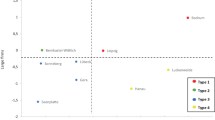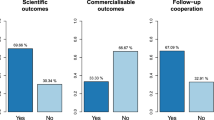Abstract
The behavior of academic researchers who engage in cooperation with industrial partners has already been the subject of considerable research. A lack of understanding exists regarding the motivations of scientific research groups to engage in cooperation with other types of external non-academic organizations and the perceived barriers that may inhibit this activity. In this paper we analyse the motivations and perceptions of risks that shape scientific research groups’ cooperation with industry and government partners. We find that motivations to cooperate are partly dependent on the type of partner organization involved, with advancing research goals mainly acting as an inducement to cooperate with government agencies, while searching for opportunities to apply knowledge motivates partnerships with firms. We also find that the majority of research groups cooperate with both firms and government, with their major motivation being to apply their knowledge. Among research groups that only cooperate with firms, interaction effects between motivations influence the likelihood of cooperation. Research groups do not consider risk to scientific autonomy a barrier to cooperating with firms, while risk to scientific credibility inhibits cooperation independently of the type of external partner. However, being motivated to advance research can reduce the effect of perceived barriers, independent of the type of partner organisation.


Similar content being viewed by others
Notes
In our study we consider a research group that which works as a stable team, usually consisting of one leader and several researchers at different stages in their professional careers. Team members share goals, resources and research activities.
The error for each region was: Andalusia, ±6.1 %; Madrid, ±5.2 %; Canary Island, ±6.8 %; and Basque Country, ±6.3 %.
Although researchers working at CSIC or universities are part of PSROs, Teirlinck and Spithoven (2012) suggest distinguishing between public research institutes and universities due to their particularities in terms of research orientation (development and applied research versus basic research), research facilities (related to scale and complexity) and the management of research.
Post-hoc results are not presented in Table 4 for space reasons.
For space reasons results only include information for the model with main effects and the final model including three-way interaction term. Proposed models guarantee the importance of the full model because the adjusted-R2 increases in each model: baseline model, adj-R2 = 13 %; main effects model, adj-R2 = 17.3 %; two-way interaction model, adj-R2 = 18.3 %; full model, adj-R2 = 19.7 %.
References
Adams, J., Clemens, E. S., & Orloff, A. S. (2005). Introduction: Social theory, modernity and the three waves of historical sociology. Remaking modernity: Politics, history and sociology (pp. 1–72). Durham and London: Duke University Press.
Agrawal, A., & Henderson, R. (2002). Putting patents in context: Exploring knowledge transfer from MIT. Management Science, 48(1), 44–60.
Aiken, L. S., & West, S. G. (1991). Multiple regression: Testing and interpreting interactions. Newbury Park, CA: Sage.
Bekkers, R., & Bodas Freitas, I. M. (2008). Analysing knowledge transfer channels between universities and industry: To what degree do sectors also matter? Research Policy, 37(10), 1837–1853.
Belderbos, R., Carree, M., Lokshin, B., & Fernández Sastre, J. (2015). Inter-temporal patterns of R&D collaboration and innovative performance. Journal of Technology Transfer, 40, 123–137.
Bercovitz, J., & Feldman, M. (2008). Academic entrepreneurs: Organizational change at the individual level. Organization Science, 19(1), 69–89.
Bolli, T., & Woerter, M. (2013). Competition and R&D cooperation with universities and competitors. Journal of Technology Transfer, 38, 768–787.
Boschma, R. (2005). Proximity and Innovation: A critical assessment. Regional Studies, 39(1), 61–74.
Bozeman, B., Fay, D., & Slade, C. P. (2013). Research collaboration in universities and academic entrepreneurship: the-state-of-the-art. The Journal of Technology Transfer, 38(1), 1–67.
Chompalov, I., Genuth, J., & Shrum, W. (2002). The organization of scientific collaborations. Research Policy, 31, 749–767.
CSIC. (2011). Annual report. http://documenta.wi.csic.es/alfresco/downloadpublic/direct/workspace/SpacesStore/08fa1688-66c9-4229-9847-f234b0bef062/MemoriaCSIC2011ing.pdf
Cunningham, J., & Harney, B. (2006). Strategic management of technology transfer: The new challenge on campus.
D’Este, P., & Perkmann, M. (2011). Why do academics engage with industry? The entrepreneurial university and individual motivations. The Journal of Technology Transfer, 36(3), 316–339.
Dasgupta, P., & David, P. A. (1994). Toward a new economies of science. Research Policy, 23, 483–521.
D’Este, P., & Patel, P. (2007). University–industry linkages in the UK: What are the factors underlying the variety of interactions with industry? Research Policy, 36(9), 1295–1313. doi:10.1016/j.respol.2007.05.002.
Dolfsma, W., & Verburg, R. (2008). Structure, agency and the role of values in processes of institutional change. Journal of Economic Issues, 42(4), 1031–1054.
Dornbusch, F., & Neuhäuser, P. (2015). Composition of inventor teams and technological progress—The role of collaboration between academia and industry. Research Policy, 44, 1360–1375.
Florida, R. L., & Cohen, W. M. (1999). Engine or infraestructure? The university role in economic development. In L. M. Branscomb, F. Kodama, & R. L. Florida (Eds.), Industrializing knowledge. Cambridge, MA: MIT Press.
Geisler, E. (1995). Industry–university technology cooperation: A theory of inter-organizational relationships. Technology Analysis & Strategic Management, 7(2), 217–229.
Geuna, A., & Nesta, L. J. J. (2006). University patenting and its effects on academic research: The emerging European evidence. Research Policy, 35(6), 790–807.
Hair, J. F. Jr., Anderson, R. E., Tatham, R. L., & Black, W. C. (1998). Multivariate data analysis (5th ed). NJ: Prentice Hall.
Hall, B. H., Link, A. N., & Scott, J. T. (2001). Barriers inhibiting industry from partnering with universities: Evidence from the advanced technology program. Journal of Technology Transfer, 26, 87–98.
Hall, B. H., Link, A. N., & Scott, J. T. (2003). Universities as research partners. The Review of Economics and Statistics, 85(2), 485–491.
INE. (2011). R&D survey. National Statistics Institute.
Katz, J. S., & Martin, B. R. (1997). What is research collaboration? Research Policy, 26(1), 1–18.
Lam, A. (2011). University–industry collaboration: Careers and knowledge governance in hybrid organisational space. International Journal of Strategic Business Alliances, 2(1), 135–145.
Landry, R., Amara, N., & Ouimet, M. (2007). Determinants of knowledge transfer: Evidence from Canadian university researchers in natural sciences and engineering. The Journal of Technology Transfer, 32(6), 561–592.
Larédo, P., & Mustar, P. (2001). Research and innovation policies in the new global economy: An international comparative analysis. Edward Elgar Publishing.
Lee, Y. (1996). Technology transfer’ and the research university: A search for the boundaries of university–industry collaboration. Research Policy, 25(6), 843–863.
Lee, S., & Bozeman, B. (2005). The impact of research collaboration on scientific productivity. Social Studies of Science, 35(5), 673–702.
Leyden, D. P., & Link, A. N. (2013). Knowledge spillovers, collective entrepreneurship, and economic growth: The role of universities. Small Business Economics, 41, 797–817.
Link, A. N., & Scott, J. T. (2005). Universities as partners in U.S. research joint ventures. Research Policy, 34, 385–393.
Martinelli, A., Meyer, M., & von Tunzelmann, N. (2008). Becoming an entrepreneurial university? A case study of knowledge exchange relationships and faculty attitudes in a medium-sized, research-oriented university. The Journal of Technology Transfer, 33(3), 259–283.
Martin-Sempere, M. J., Rey-Rocha, J., & Garzün-García, B. (2002). Assessing quality of domestic scientific journals in geographically oriented disciplines: Scientists’ judgements versus citations. Research Evaluation, 11(3), 149–154.
McFadden, D. (1974). The measurement of urban travel demand. Journal of Public Economics, 3, 303–328.
Merton, R. (1973). The sociology of science. Chicago: University of Chicago Press.
Meyer-Krahmer, F., & Schmoch, U. (1998). Science-based technologies: University–industry interactions in four fields. Research Policy, 27(8), 835–851.
Nelson, R. (2001). Observations on the Post–Bayh–Dole rise of patenting at american universities. Journal of Technology Transfer, 26, 13–19.
OECD. (1999). Science, technology and industry scoreboard 1999. Benchmarking Knowledge-based economies. Paris.
Olmos-Peñuela, J., Benneworth, P. & Castro-Martínez, E. (2013). Are ‘STEM from Mars and SSH from Venus’? Challenging disciplinary stereotypes of research’s social value. Science and Public Policy, 3, 1–17.
Olmos-Peñuela, J., Castro Martínez, E., & D’Este, P. (2014). Knowledge transfer activities in social sciences and humanities: Explaining the interactions of research groups withnon-academic agents. Research Policy, 43, 696–706.
Organ, D. J., & Cunningham, J. (2011). Entrepreneurship in the Academy: The case for a micro-institutional analysis. Paper presented at the DRUID 2011 on Innovation, Strategy, and Structure—Organizations, Institutions, Systems and Regions at Copenhagen Business School, Denmark, June 15–17, 2011. http://druid8.sit.aau.dk/acc_papers/ch4ofat732qeko92ggrmbha2jv61.pdf
Owen-Smith, J. & Powell, W. W. (2001). Careers and Contradictions: Faculty Responses to the Transformation of Knowledge and Its Uses in the Life Sciences. Research in the Sociology of Work, 10, 109–140.
Perkmann, M., Tartari, V., McKelvey, M., Autio, E., Broström, A., D’Este, P., et al. (2013). Academic engagement and commercialisation: A review of the literature on university–industry relations. Research Policy, 42(2), 423–442.
Polyani, M. (1962). The republic of science: Its political and economic theory. Minerva, 1, 54–74.
Powell, W. W., Koput, K. W., & Smith-Doerr, L. (1996). Interorganizational collaboration and the locus of innovation: Networks of learning in biotechnology. Administrative Science Quarterly, 41, 116–145.
Ramos-Vielba, I. (Coord.) (2011). Una revisión de los sistemas regionales de I + D: Andalucía, Canarias, Madrid y País Vasco. Madrid: Fundación Ideas para el Progreso. ICUE: Ideas Cooperación Universidad-Empresas.
Rey Rocha, J., Martín Sempere, M. J., & Sebastián, J. (2008). Estructura y dinámica de los grupos de investigación. Arbor, 184(732), 743–757.
Rokeach, M. (1979). From individual to institutional values. In M. Rokeach (Ed.), Understanding human values (pp. 47–70). New York: Free Press.
Sánchez-Barrioluengo, M. (2014). Aticulating the ‘three missions’ in Spanish universities. Research Policy. doi:10.1016/j.respol.2014.06.001
Santoro, M. D., & Gopalakrishnan, S. (2000). The institutionalization of knowledge transfer activities within industry–university collaborative ventures. Journal of Engineering and Technology Management, 17(3–4), 299–319. doi:10.1016/S0923-4748(00)00027-8.
Sarewitz, D., & Pielke, R. A. (2007). The neglected heart of science policy: Reconciling supply and demand for science. Environmental Science & Policy, 10, 5–16.
Schartinger, D. (2002). Knowledge interactions between universities and industry in Austria: Sectoral patterns and determinants. Research Policy, 31(3), 303–328.
Shalley, C. E., Gilson, L. L., & Blum, T. B. (2009). Interactive effects of growth need strength, work context, and job complexity on self-reported creative performance. Academy of Management Journal, 52(3), 489–505.
Siegel, D. S., Waldman, D. A., Atwater, L. E., & Link, A. N. (2003). Commercial knowledge transfers from universities to firms: Improving the effectiveness of university–industry collaboration. The Journal of High Technology Management Research, 14(1), 111–133.
Slaughter, S., & Rhoades, G. (1996). The emergence of a competitiveness research and development policy coalition and the commercialization of academic science and technology. Science, Technology and Human Values, 21, 303–339.
Tartari, V., & Breschi, S. (2012). Set them free: scientists’ evaluations of the benefits and costs of university–industry research collaboration. Industrial and Corporate Change, 21(5), 1117–1147.
Tartari, V., Salter, A., & D’Este, P. (2012). Crossing the Rubicon: exploring the factors that shape academics’ perceptions of the barriers to working with industry. Cambridge Journal of Economics, 36(3), 655–677.
Teirlinck, P., & Spithoven, A. (2012). Fostering industry-science cooperation through public funding: differences between universities and public rsearch centres-. Journal of Technology Transfer, 37, 676–695.
Thune, T. (2007). University–industry collaboration: The network embeddedness approach. Science and Public Policy, 34(3), 158–168.
Thune, T., & Gulbrandsen, M. (2014). Dynamics of collaboration in university–industry partnerships: Do initial conditions explain development patterns? Journal of Technology Transfer, 39, 977–993.
Turpin, T., & Fernández-Esquinas, M. (2011). The policy rationale for cross-sector research collaboration and contemporary consequences. Science and Public Policy, 38(2), 82–86.
Woolgar, L. (2007). New institutional policies for university–industry links in Japan. Research Policy, 36(8), 1261–1274. doi:10.1016/j.respol.2007.04.010.
Acknowledgments
Funding for this project (Ref. CSO2009-07805) was provided by the Spanish National Programme of Scientific Research, Development and Innovation. A preliminary version of the manuscript was presented at the EU-SPRI 2014 Manchester Conference, University of Manchester (June 2014). Thanks are due to session Chair Niki Vermeulen and conference delegates for the valuable comments and suggestions provided. Comments from Pablo D’Este and Elisabetta Marinelli, on an early draft of this paper, and Julia Olmos-Peñuela, on a later version, are also gratefully acknowledged.
Author information
Authors and Affiliations
Corresponding author
Appendix
Rights and permissions
About this article
Cite this article
Ramos-Vielba, I., Sánchez-Barrioluengo, M. & Woolley, R. Scientific research groups’ cooperation with firms and government agencies: motivations and barriers. J Technol Transf 41, 558–585 (2016). https://doi.org/10.1007/s10961-015-9429-4
Published:
Issue Date:
DOI: https://doi.org/10.1007/s10961-015-9429-4




